Spatial Analysis of Structure and Metal Mineralization Based on Fractal Theory and Fry Analysis: A Case Study in Nenjiang−Heihe Metallogenic Belt
Abstract
1. Introduction
2. Geological Background
3. Methods
3.1. Preprocessing and Linear Construction Extraction
3.2. Box-Counting Fractal Model
3.3. Fry Analysis
4. Results and Discussion
4.1. Analysis of Linear Structure Extraction Results
4.2. Analysis of Linear Constructs Based on Fractal Dimension
4.3. Analysis of Linear Constructs Based on Fractal Dimension
5. Conclusions
Author Contributions
Funding
Data Availability Statement
Acknowledgments
Conflicts of Interest
References
- Adib, A.; Afzal, P.; Ilani, S.M.; Aliyari, F. Determination of the relationship between major fault and zinc mineralization using fractal modeling in the Behabad fault zone, central Iran. J. Afr. Earth Sci. 2017, 134, 308–319. [Google Scholar] [CrossRef]
- Austin, J.; Blenkinsop, T.G. Local to regional scale structural controls on mineralisation and the importance of a major lineament in the eastern Mount Isa Inlier, Australia: Review and analysis with autocorrelation and weights of evidence. Ore Geol. Rev. 2009, 35, 298–316. [Google Scholar] [CrossRef]
- Bierlein, F.P.; Murphy, F.C.; Weinberg, R.F.; Lees, T. Distribution of orogenic gold deposits in relation to fault zones and gravity gradients: Targeting tools applied to the Eastern Goldfields, Yilgarn Craton, Western Australia. Miner. Depos. 2006, 41, 107–126. [Google Scholar] [CrossRef]
- Carranza, E.J.M.; Hale, M. Spatial association of mineral occurrences and curvilinear geological features. Math. Geol. 2002, 34, 203–221. [Google Scholar] [CrossRef]
- Chernicoff, C.J.; Richards, J.P.; Zappettini, E.O. Crustal lineament control on magmatism and mineralization in northwestern Argentina: Geological, geophysical, and remote sensing evidence. Ore Geol. Rev. 2002, 21, 127–155. [Google Scholar] [CrossRef]
- Groves, D.I.; Bierlein, F.P. Geodynamic settings of mineral deposit systems. J. Geol. Soc. 2007, 164, 19–30. [Google Scholar] [CrossRef]
- Mirzaie, A.; Bafti, S.S.; Derakhshani, R. Fault control on Cu mineralization in the Kerman porphyry copper belt, SE Iran: A fractal analysis. Ore Geol. Rev. 2015, 71, 237–247. [Google Scholar] [CrossRef]
- Safari, H.O.; Bagas, L.; Bafti, B.S. Structural controls on the localization of Cu deposits in the Kerman Cu metallogenic province of Iran using geoinformatic techniques. Ore Geol. Rev. 2015, 67, 43–56. [Google Scholar] [CrossRef]
- Afzal, P.; Ahari, H.D.; Omran, N.R.; Aliyari, F. Delineation of gold mineralized zones using concentration–volume fractal model in Qolqoleh gold deposit, NW Iran. Ore Geol. Rev. 2013, 55, 125–133. [Google Scholar] [CrossRef]
- Carranza, E.J.M.; Sadeghi, M. Post-VMS mineralization deformations (1880–1820 Ma) of the Skellefte district (Sweden): Insights from the spatial pattern of VMS occurrences. Front. Earth Sci. 2014, 8, 319–324. [Google Scholar] [CrossRef]
- Carranza, E.J.M.; Owusu, E.A.; Hale, M. Mapping of prospectivity and estimation of number of undiscovered prospects for lode gold, southwestern Ashanti Belt, Ghana. Miner. Depos. 2009, 44, 915–938. [Google Scholar] [CrossRef]
- Zhao, Z.; Qiao, K.; Liu, Y.; Chen, J.; Li, C. Geochemical Data Mining by Integrated Multivariate Component Data Analysis: The Heilongjiang Duobaoshan Area (China) Case Study. Minerals 2022, 12, 1035. [Google Scholar] [CrossRef]
- Lin, N.; Chen, Y.; Liu, H.; Liu, H. A comparative study of machine learning models with hyperparameter optimization algorithm for mapping mineral prospectivity. Minerals 2021, 11, 159. [Google Scholar] [CrossRef]
- Du, X.; Zhou, K.; Cui, Y.; Wang, J.; Zhou, S. Mapping Mineral Prospectivity Using a Hybrid Genetic Algorithm–Support Vector Machine (GA–SVM) Model. ISPRS Int. J. Geo-Inf. 2021, 10, 766. [Google Scholar] [CrossRef]
- Carranza, E.J.M. Controls on mineral deposit occurrence inferred from analysis of their spatial pattern and spatial association with geological features—ScienceDirect. Ore Geol. Rev. 2009, 35, 383–400. [Google Scholar] [CrossRef]
- Maanijou, M.; Daneshvar, N.; Alipoor, R.; Azizi, H. Spatial analysis on gold mineralization in Southwest Saqqez using point pattern, fry and fractal analyses. Geotectonics 2020, 54, 589–604. [Google Scholar] [CrossRef]
- Liu, Z.; Han, L.; Du, C.; Cao, H.; Wang, H. Fractal and Multifractal Characteristics of Lineaments in the Qianhe Graben and Its Tectonic Significance Using Remote Sensing Images. Remote Sens. 2021, 13, 587. [Google Scholar] [CrossRef]
- Ni, C.; Zhang, S.; Chen, Z.; Yan, Y.; Li, Y. Mapping the spatial distribution and characteristics of lineaments using fractal and multifractal models: A case study from northeastern Yunnan Province, China. Sci. Rep. 2017, 7, 1–11. [Google Scholar] [CrossRef]
- Tan, K.X.; Xie, Y.S. Multifractal mechanism of faults controlling hydrothermal deposits in altay, Xinjiang, China. Geotecton. Et Metallog. 2010, 34, 32–39. [Google Scholar]
- Lei, T.C.; Cui, F.; Yu, F.M.; Xu, H.G. Study on fractal feature of fault structure and its geological implications based on remote sensing: A case study of Jiuyi Mountain area, Southern Hunan. Geol. Rev. 2012, 58, 594–600. [Google Scholar]
- Ma, A.; Mm, A.; Pa, B.; Abyc, D.; Ejc, E. Fractal modeling and fry analysis of the relationship between structures and Cu mineralization in Saveh region, Central Iran. Ore Geol. Rev. 2019, 107, 172–185. [Google Scholar]
- Jiang, C.; Li, S.H.; Fu, S.; Xie, Z.L.; Liao, H.W. Tectonic fractal and mentallogenic prediction in Northwest Dayao Mountain, Guangxi. Acta Geosci. Sin. 2021, 42, 514–526. [Google Scholar]
- Blenkinsop, T.G.; Kadzviti, S. Fluid flow in shear zones: Insights from the geometry and evolution of ore bodies at Renco gold mine, Zimbabwe. Geofluids 2006, 6, 334–345. [Google Scholar] [CrossRef]
- Kreuzer, O.; Blenkinsop, T.G.; Morrison, R.; Peters, S. Ore controls in the Charters Towers goldfield, NE Australia: Constraints from geological, geophysical and numerical analyses. Ore Geol. Rev. 2007, 32, 37–80. [Google Scholar] [CrossRef]
- Parsa, M.; Maghsoudi, A. Controls on Mississippi Valley-Type Zn-Pb mineralization in Behabad district, Central Iran: Constraints from spatial and numerical analyses. J. Afr. Earth Sci. 2018, 140, 189–198. [Google Scholar] [CrossRef]
- Stubley, M. Spatial distribution of kimberlite in the Slave craton, Canada: A geometrical approach. Lithos 2004, 77, 683–693. [Google Scholar] [CrossRef]
- Vearncombe, J.; Vearncombe, S. The spatial distribution of mineralization; applications of Fry analysis. Econ. Geol. 1999, 94, 475–486. [Google Scholar] [CrossRef]
- Behyari, M.; Rahimsouri, Y.; Hoseinzadeh, E.; Kurd, N. Evaluating of lithological and structural controls on the barite mineralization by using the remote sensing, Fry and fractal methods, Northwest Iran. Arab. J. Geosci. 2019, 12, 1–11. [Google Scholar] [CrossRef]
- Lisitsin, V. Spatial data analysis of mineral deposit point patterns: Applications to exploration targeting. Ore Geol. Rev. 2015, 71, 861–881. [Google Scholar] [CrossRef]
- Bie, L.D.; Chen, J.P.; Liu, J.P.; Yan, Q. Coal mine distribution characteristics in Chengde region and their fractal research controlled by faults. J. Geol. 2011, 35, 38–44. [Google Scholar]
- Jahn, B.M. The Central Asian Orogenic Belt and growth of the continental crust in the Phanerozoic. Geol. Soc. Lond. Spec. Publ. 2004, 226, 73–100. [Google Scholar] [CrossRef]
- Jahn, B.M.; Wu, F.; Chen, B. Massive granitoid generation in Central Asia: Nd isotope evidence and implication for continental growth in the Phanerozoic. Epis. J. Int. Geosci. 2000, 23, 82–92. [Google Scholar] [CrossRef]
- Kovalenko, V.I.; Yarmolyuk, V.V.; Kovach, V.P.; Kotov, A.B.; Kozakov, I.K.; Salnikova, E.B.; Larin, A.M. Isotope provinces, mechanisms of generation and sources of the continental crust in the Central Asian mobile belt: Geological and isotopic evidence. J. Asian Earth Sci. 2004, 23, 605–627. [Google Scholar] [CrossRef]
- Windley, B.F.; Alexeiev, D.; Xiao, W.; Kroner, A.; Badarch, G. Tectonic models for accretion of the Central Asian Orogenic Belt. J. Geol. Soc. 2007, 164, 31–47. [Google Scholar] [CrossRef]
- Wu, F.Y.; Jahn, B.M.; Wilde, S.A.; Lo, C.H.; Sun, D.Y. Highly fractionated I-type granites in NE China (II): Isotopic geochemistry and implications for crustal growth in the Phanerozoic. Lithos 2003, 67, 191–204. [Google Scholar] [CrossRef]
- Zhao, Z.H.; Sun, J.G.; Li, G.H.; Xu, W.X.; Lü, C.L.; Guo, Y.; Liu, J.; Zhang, X. Zircon U–Pb geochronology and Sr–Nd–Pb–Hf isotopic constraints on the timing and origin of the Early Cretaceous igneous rocks in the Yongxin gold deposit in the Lesser Xing’an Range, NE China. Geol. J. 2020, 55, 2684–2703. [Google Scholar] [CrossRef]
- Zheng, Y.F.; Xiao, W.J.; Zhao, G. Introduction to tectonics of China. Gondwana Res. Int. Geosci. J. 2013, 23, 1189–1206. [Google Scholar] [CrossRef]
- Li, C.L.; Li, S.R.; Yuan, M.W.; Du, B.Y.; Li, W.L.; Liu, D.Y.; Liu, H. Genesis of the Keluo Au deposit in the Nenjiang-Heihe tectonic melangebelt, Heilongjiang Province: Evidence from chemical composition and pyrite He-Ar, S, Pb isotopes. Earth Sci. Front. 2020, 27, 99–115. [Google Scholar]
- Yin, G.L.; Lyu, C.L.; Cui, Y.J.; Shi, G.M.; Yu, Y.J.; Yang, F.S.; Jiang, H.J. Tectono-geochemical characteristics and geological insignificance in arc basin system of Da Hinggan Mountains. Miner. Resour. Geol. 2018, 32, 553–561. [Google Scholar]
- Li, C.L.; Xu, W.X.; Li, S.R.; Song, Z.C.; Wang, Z.; Qu, H.; Xu, Z.G. Zircon U-Pb ages, geochemical characteristics and tectonicimplications of the early permian granites in Huolongmenarea, northeast Da Hinggan Mountains. Mineral. Petrol. 2017, 37, 46–54. [Google Scholar]
- Han, G.; Liu, Y.; Neubauer, F.; Jin, W.; Genser, J.; Ren, S.; Li, W.; Wen, Q.; Zhao, Y.; Liang, C. LA-ICP-MS U–Pb dating and Hf isotopic compositions of detrital zircons from the Permian sandstones in Da Xing’an Mountains, NE China: New evidence for the eastern extension of the Erenhot–Hegenshan suture zone. J. Asian Earth Sci. 2012, 49, 249–271. [Google Scholar] [CrossRef]
- Fu, J.; Wang, Y.; Na, F.C.; Yang, F.; Zhang, G.Y.; Liu, Y.C.; Kang, Z. Geology of the Hadayang tectonic mélange in Inner Mongolia: Discovery significance. Geol. Resour. 2015, 24, 408–413. [Google Scholar]
- Li, Y.; Fu, J.J.; Zhao, Y.Y.; Zeng, H. Chronological characteristics and metallogenic significance of Zhengguang gold deposit, Heilongjiang Province, China. Acta Geol. Sin. 2016, 90, 151–162. [Google Scholar]
- Song, G.X.; Qin, K.Z.; Wang, L.; Guo, J.H.; Li, Z.Z.; Tong, K.Y.; Zou, X.Y.; Li, G.M. Type, zircon U-Pb age and Paleo-volcano edifice of Zhengguang gold depositin Duobaoshan orefield in Heilongjiang Province, NE-China. Acta Petrol. Sin. 2015, 31, 2402–2416. [Google Scholar]
- Gao, R.; Xue, C.; Lü, X.; Zhao, X.; Yang, Y.; Li, C. Genesis of the Zhengguang gold deposit in the Duobaoshan ore field, Heilongjiang Province, NE China: Constraints from geology, geochronology and S-Pb isotopic compositions. Ore Geol. Rev. 2017, 84, 202–217. [Google Scholar] [CrossRef]
- Zhao, Z.H.; Sun, J.G.; Li, G.H.; Xu, W.X.; Lü, C.L.; Wu, S.; Guo, Y.; Liu, J.; Ren, L. Early Cretaceous gold mineralization in the Lesser Xing’an Range of NE China: The Yongxin example. Int. Geol. Rev. 2019, 61, 1522–1549. [Google Scholar] [CrossRef]
- Li, C.L. Gold Metallogeny and Prospecting in the Nenjiang-Heihe Tectonic Melange Zone, Heilongjiang Province; China University of Geosciences: Beijing, China, 2018. [Google Scholar]
- Xiang, A.P.; Yang, X.C.; Li, G.T.; She, H.Q.; Guan, J.D.; Li, J.W.; Guo, Z.J. Diagenetic and metallogenic ages of Duobaoshan porphyry Cu-Mo depositin Heilongjiang Province. Miner. Depos. 2012, 31, 1237–1248. [Google Scholar]
- Wang, L.; Qin, K.Z.; Pang, X.Y.; Song, G.X.; Jin, L.Y.; Li, G.M.; Zhao, C. Geological characteristics and alteration zonation of Tongshan porphyry copper deposit within Duobaoshan orefield, Heilongjiang: Implications for hydrothermal-mineralization center and further exploration. Miner. Depos. 2017, 36, 1143–1168. [Google Scholar]
- Zeng, Q.D.; Liu, J.M.; Chu, S.X.; Wang, Y.B.; Sun, Y.; Duan, X.X.; Zhou, L.L.; Qu, W.J. Re–Os and U–Pb geochronology of the Duobaoshan porphyry Cu–Mo–(Au) deposit, northeast China, and its geological significance. J. Asian Earth Sci. 2014, 79, 895–909. [Google Scholar] [CrossRef]
- Zhao, Z.H.; Zheng, W.Z.; Qu, H.; Guo, Y.; Li, C.L.; Wang, Z.; Zhang, J.F. Cu-Au mineralization and metallogenic regularity of Duobaoshan area, Heilongjiang Province. Miner. Depos. 2012, 31, 601–614. [Google Scholar]
- Deng, K.; Chen, Y.J.; Zhang, C.; Xu, W.Q.; Zhu, X.F. Mineralogical characteristics and ore-forming physicochemical conditions of the Sankuanggou skarn Fe-Cu deposit, Heilongjiang Province. Earth Sci. Front. 2018, 25, 167–182. [Google Scholar]
- Hao, J.Y. Mineralization and Metallogenic Regularity of DuobaoshanOre Concentration Area in Heilongjiang Province, Northeast China; Jilin University: Changchun, China, 2015. [Google Scholar]
- Zhai, D.G.; Wang, J.P.; Liu, J.J.; Ripley, E.M. Geochronological and He-Ar-S isotopic constraints on the origin of the Sandaowanzi gold-telluride deposit, northeastern China. Lithos Int. J. Mineral. Petrol. Geochem. 2015, 212, 338–352. [Google Scholar] [CrossRef]
- Zhao, Z.H.; Chen, J.; Qiao, K.; Cui, X.M.; Sun, J.G.; Li, C.L.; Yang, Y. Ore-fluid sources and genesis of Yongxin gold deposit in northwestern XiaoHinggan Mountains: Constraint from fluid inclusions and H-O-S-Pb isotopes. Miner. Depos. 2021, 40, 221–240. [Google Scholar]
- Ge, W.; Wu, F.; Zhou, C.; Zhang, J. Porphyry Cu-Mo deposits in the eastern Xing’an-Mongolian Orogenic Belt: Mineralization ages and their geodynamic implications. Chin. Sci. Bull. 2007, 52, 3416–3427. [Google Scholar] [CrossRef]
- Hao, Y.J.; Ren, Y.S.; Duan, M.X.; Tong, K.Y.; Chao, L. Metallogenic events and tectonic setting of the Duobaoshan ore field in Heilongjiang Province, NE China. J. Asian Earth Ences 2015, 97, 442–458. [Google Scholar] [CrossRef]
- Liu, J.; Wu, G.; Li, Y.; Zhu, M.; Zhong, W. Re–Os sulfide (chalcopyrite, pyrite and molybdenite) systematics and fluid inclusion study of the Duobaoshan porphyry Cu (Mo) deposit, Heilongjiang Province, China. J. Asian Earth Sci. 2012, 49, 300–312. [Google Scholar] [CrossRef]
- Cui, G.; Wang, J.Y.; Zhang, J.X.; Cui, G. U-Pb SHRIMP dating of zircons from Duobaoshan granodiorite in Heilongjiang and its geological significance. Glob. Geol. 2008, 27, 387–394. [Google Scholar]
- Zhao, Y.M. metasomatic zoning in some major Pb-Zn polymetallic skarn deposits of China. Miner. Depos. 1997, 16, 25–34. [Google Scholar]
- Hao, B.; Deng, J.; Bagas, L.; Ge, L.; Nie, F.; Turner, S.; Min, Q. The Gaosongshan epithermal gold deposit in the Lesser Hinggan Range of the Heilongjiang Province, NE China: Implications for Early Cretaceous mineralization. Ore Geol. Rev. 2016, 73, 179–197. [Google Scholar] [CrossRef]
- Zhao, Z.H.; Sun, J.G.; Li, G.H.; Xu, W.X.; Lü, C.L.; Wu, S.; Guo, Y.; Ren, L.; Hu, Z.X. Age of the Yongxin Au deposit in the Lesser Xing’an Range: Implications for an Early Cretaceous geodynamic setting for gold mineralization in NE China. Geol. J. 2019, 54, 2525–2544. [Google Scholar] [CrossRef]
- Hermi, S.O.; Elsheikh, R.F.A.; Aziz, M.; Bouaziz, S. Structural interpretation of lineaments uses satellite images processing: A case study in North-Eastern Tunisia. J. Geogr. Inf. Syst. 2017, 9, 440. [Google Scholar] [CrossRef]
- Thannoun, R.G. Automatic Extraction and Geospatial Analysis of Lineaments and their Tectonic Significance in some areas of Northern Iraq using Remote Sensing Techniques and GIS. Int. J. Enhanc. Res. Sci. Technol. Eng. Bull. 2013, 2, 1–11. [Google Scholar]
- Akinwumiju, A.; Olorunfemi, M.; Afolabi, O. Automated lineament mapping from remotely sensed data: Case study Osun drainage basin, southwestern Nigeria. Ife J. Sci. 2016, 18, 177–201. [Google Scholar]
- Mandelbrot, B. How long is the coast of Britain? Statistical self-similarity and fractional dimension. Science 1967, 156, 636–638. [Google Scholar] [CrossRef] [PubMed]
- Li, F.; Liu, G.S.; Zhou, Q.W.; Zhan, G.B. Application of fractal theory in the study of the relationship between fracture and minera. J. Hefei Univ. Technol. (Nat. Sci.) 2016, 39, 701–706. [Google Scholar]
- Bai, H.; Cao, Y.; Zhang, H.; Wang, W.; Jiang, C.; Yang, Y. Applying Data-Driven-Based Logistic Function and Prediction-Area Plot to Map Mineral Prospectivity in the Qinling Orogenic Belt, Central China. Minerals 2022, 12, 1287. [Google Scholar] [CrossRef]
- Shen, W. Fractal Chaos and Mineral Prediction; Geological Publishing House: Beijing, China, 2002; pp. 6–48. ISBN 978-7-1160-3559-1. [Google Scholar]
- Lyu, C.; Cheng, Q.; Zuo, R.; Wang, X. Mapping spatial distribution characteristics of lineaments extracted from remote sensing image using fractal and multifractal models. J. Earth Sci. 2017, 28, 507–515. [Google Scholar] [CrossRef]
- Sun, T.; Li, H.; Wu, K.X.; Chen, L.K.; Liu, W.M.; Hu, Z.J. Fractal and multifractal characteristics of regional fractures in Tongling metallogenic Area. Nonferrous Met. Eng. 2018, 8, 111–115. [Google Scholar]
- Fry, N. Random point distributions and strain measurement in rocks. Tectonophysics 1979, 60, 89–105. [Google Scholar] [CrossRef]
- Nan, W.; Liu, Y. Fractal Characteristics of Fault Structures and Their Use for Mapping Ore–prospecting Potential in the Qitianling Area, Southern Hunan Province, China. Acta Geol. Sin. Engl. Ed. 2015, 89, 121–132. [Google Scholar] [CrossRef]
- Jin, Z.D.; Lu, X.W.; Zhang, C.L. A study of fractal dimension of the fracture system in the Dexing porphyry copper orefield, Jiangxi. Geol. Rev. 1998, 44, 57–62. [Google Scholar]
- Xie, Y.S.; Tan, K.X. Fractal research on fracture structures and application in geology. Earth Environ. 2002, 1, 71–77. [Google Scholar]
- Zhao, S.J.; Qian, J.P.; Chen, H.Y. Application of fractal statistics of linear structure and alteration information extraction of remote sensing on the Au, Pb, Zn, Sn polymetallic minerogenetic prognosis in Eastern Guangxi. Geotecton. Et Metallog. 2011, 35, 364–371. [Google Scholar]
- Ahmadirouhani, R.; Karimpour, M.H.; Rahimi, B.; Malekzadeh-Shafaroudi, A.; Pour, A.B.; Pradhan, B. Integration of Spot-5 and Aster Satellite Data for Structural Tracing and Hydrothermal Alteration Mineral Mapping: Implications for Cu–Au Prospecting. Int. J. Image Data Fusion 2018, 9, 237–262. [Google Scholar] [CrossRef]
- Shiran, M.; Asadi, M.A.Z.; Mozzi, P.; Adab, H.; Amirahmadi, A. Detection of Surface Anomalies through Fractal Analysis and Their Relation to Morphotectonics (High Zagros Belt, Iran). Geosci. J. 2020, 24, 597–613. [Google Scholar] [CrossRef]
- Tan, K.X.; Hao, X.C.; Dai, T.G. Fractal Features Of Fractures In Chinaand Their Implication Fur Geotectonics. Geotecton. Et Metallog. 1998, 1, 17–20. [Google Scholar]
- Pan, X.D.; Kang, L. Study on fractal characteristics of Hunjiang fault zone and drainage systems and activity of tectonic. J. Disaster Prev. Reduct. 2002, 4, 7–15. [Google Scholar]
- Kong, F.C.; Ding, G.Y. The implications the fractal dimension values of lineaments. Earthquake 1991, 5, 33–37. [Google Scholar]
- Zhao, Z.H.; Chen, J.; Qiao, K.; Cui, X.M.; Liang, S.S.; Li, C.L. Remote Sensing Alteration lnformation and Structure Analysis Based onFractal Theory: A Case Study of Duobaoshan Area of Heilongjiang Province. Geoscience 2022, 19, 1–16. [Google Scholar]
- Fan, C.; Tao, J.; Zhou, K.; Hu, F.; Huang, W. Fractal characteristics of reservoir structural fracture: A case study of Xujiahe Formation in central Yuanba area, Sichuan Basin. Earth Sci. Res. J. 2018, 22, 113–118. [Google Scholar] [CrossRef]
- Zerrouk, S.; Bendaoud, A.; Hamoudi, M.; Liégeois, J.P.; Boubekri, H.E.; Khaznadji, R.B. Mapping and discriminating the Pan-African granitoids in the Hoggar (southern Algeria) using Landsat 7 ETM+ data and airborne geophysics. J. Afr. Earth Sci. 2017, 127, 146–158. [Google Scholar] [CrossRef]
- Li, L.F. Fractal Feature and Fractal Dimension Analysis of Lineament in Guangxi Region; Guilin University of Technology: Guilin, China, 2017. [Google Scholar]
- Zhu, X.H.; Wang, J. On relationship between the fractal and scales—A case study of China’s continental mountain ridges. J. Geo-Inf. Sci. 2003, 16, 67–72. [Google Scholar]
- Li, S.M.; Yao, S.Z.; Han, Y.C. Using tendency analysis method to deal with geochemical databased on the surfer software. Geol. Explor. 2007, 43, 72–75. [Google Scholar]
- Li, Z.R.; Zhang, K.; Li, X.M.; Li, D.L.; Ma, S.B. Analysis of linear structural characteristics of remote sensing and prediction of ore finding. Remote Sens. Inf. 2016, 31, 115–121. [Google Scholar]
- Hao, M.; Wu, H.; Jia, Z.Q.; Huang, D.N.; Liu, Y.; Guan, Z. Discussion on genetic correlation between Huashan granite body and Guposhan granite body based on comparative analysis of fault structure features in remote sensing image. Remote Sens. Land Resour. 2014, 26, 162–169. [Google Scholar]
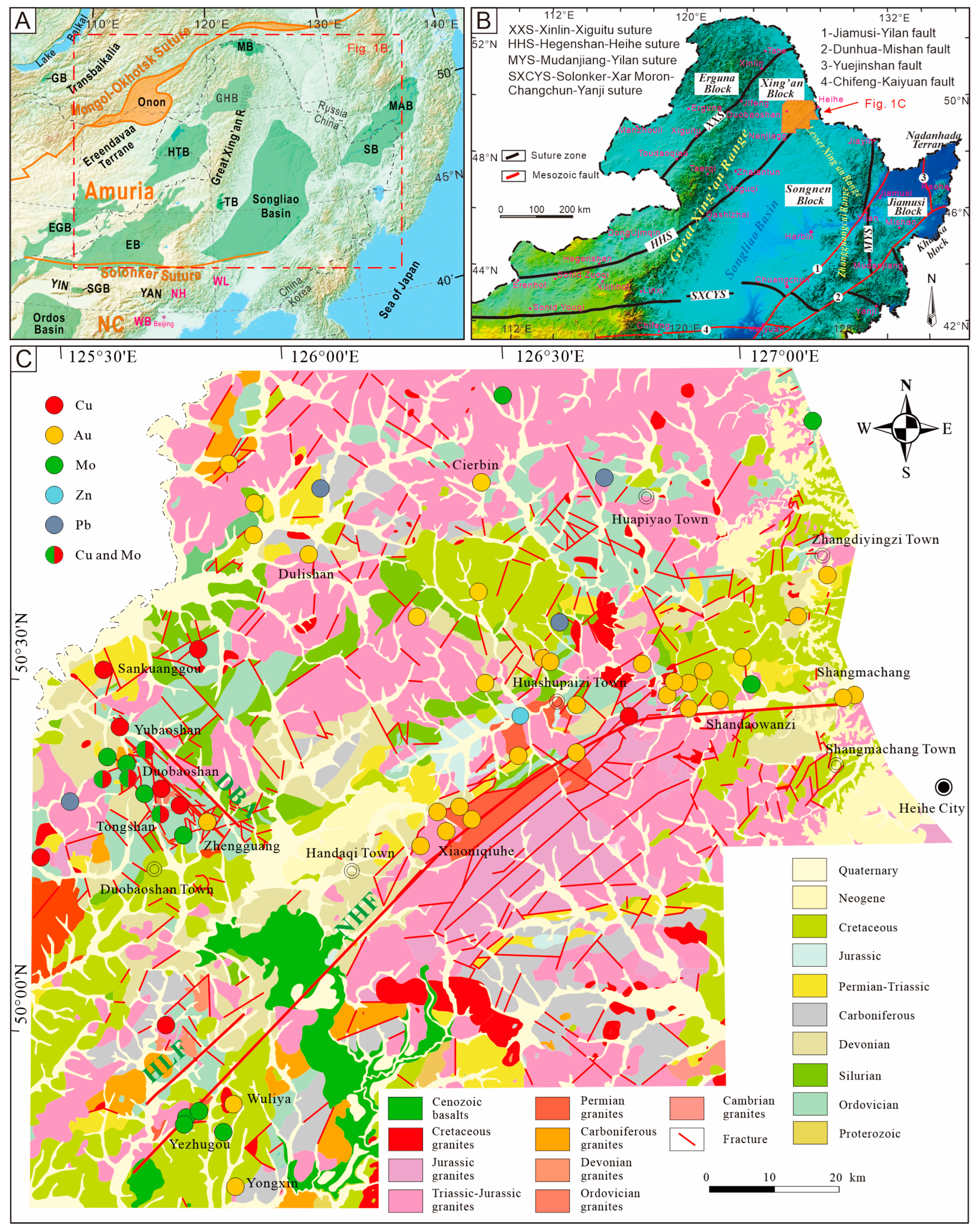
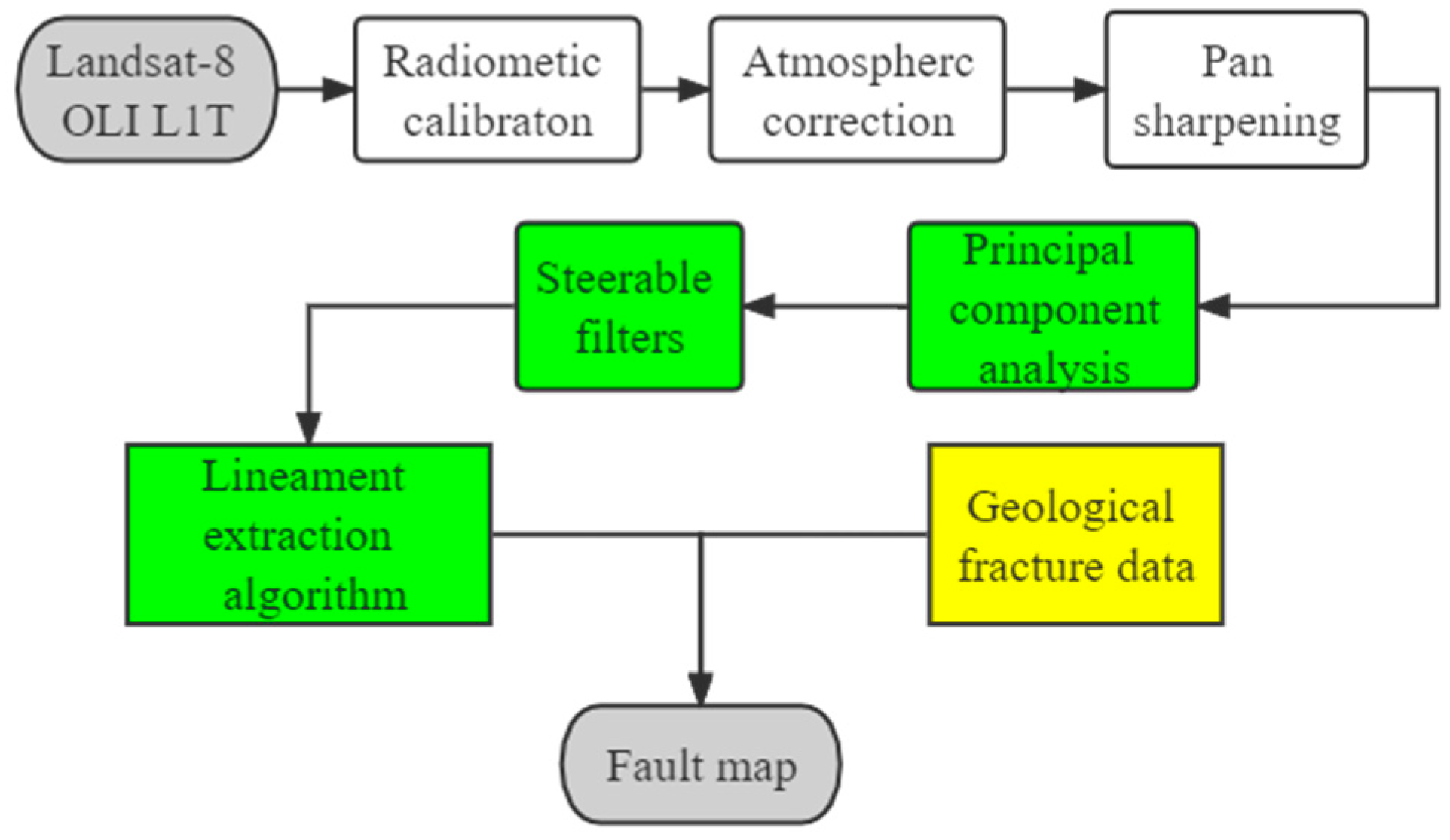
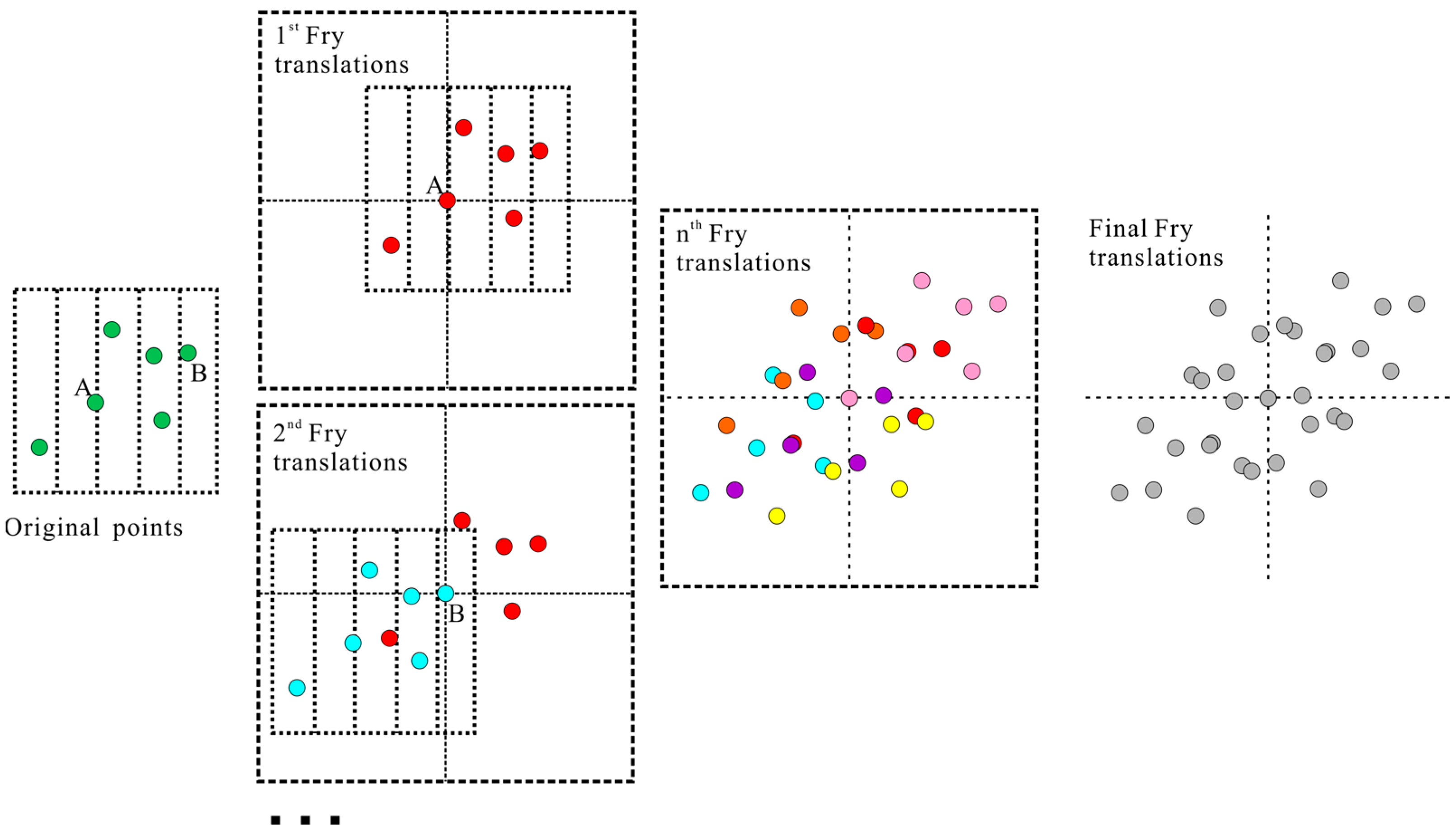
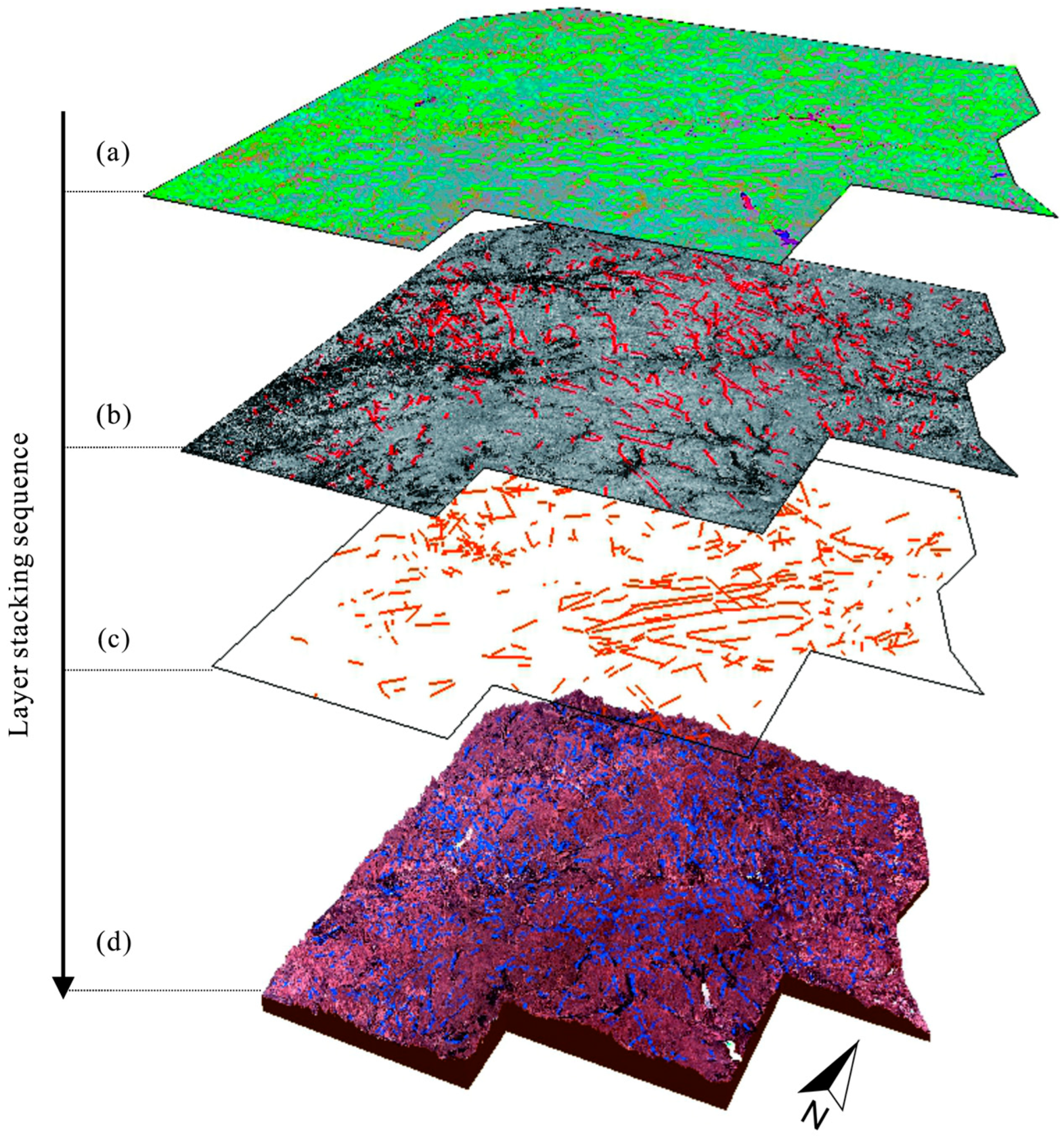

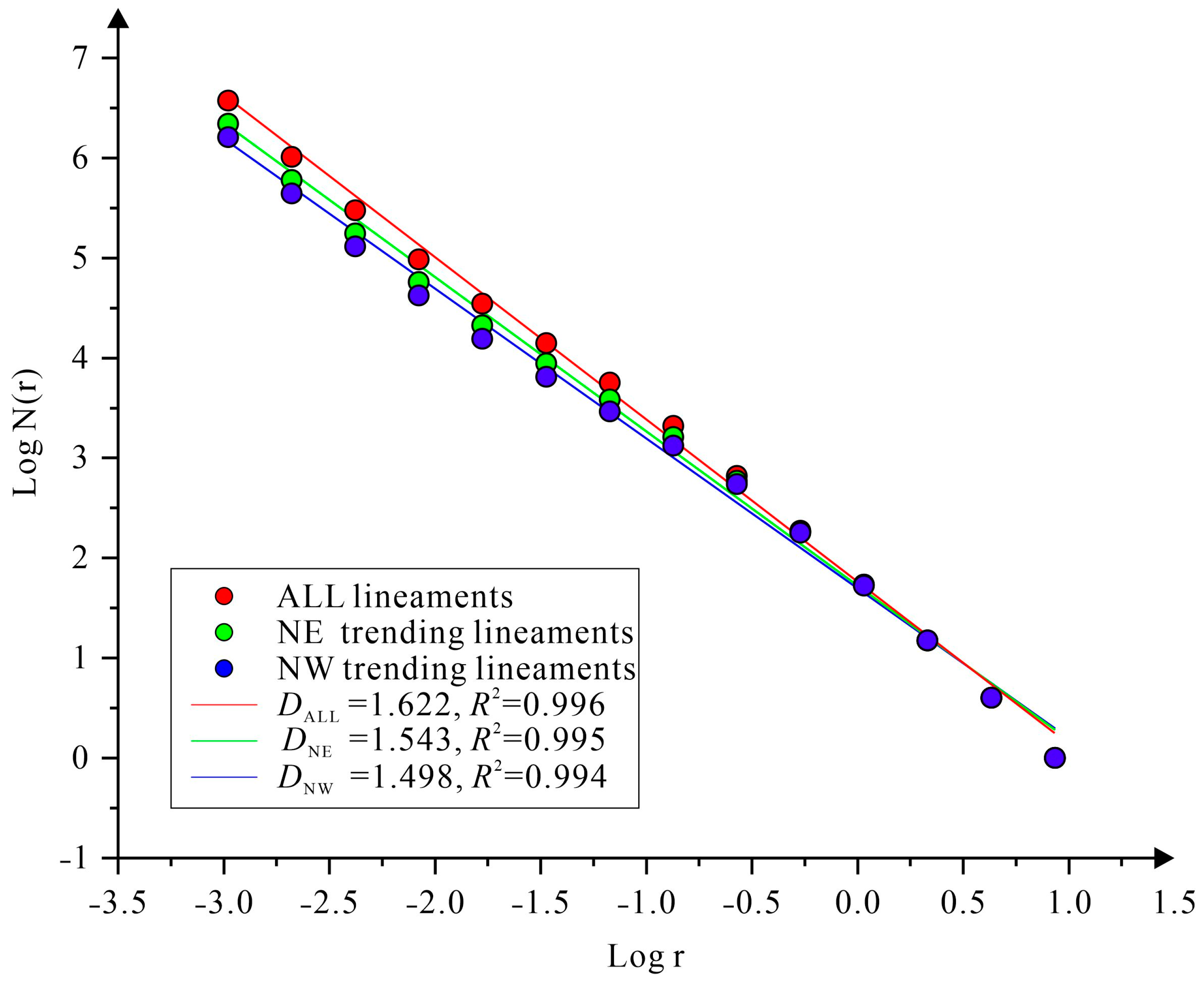
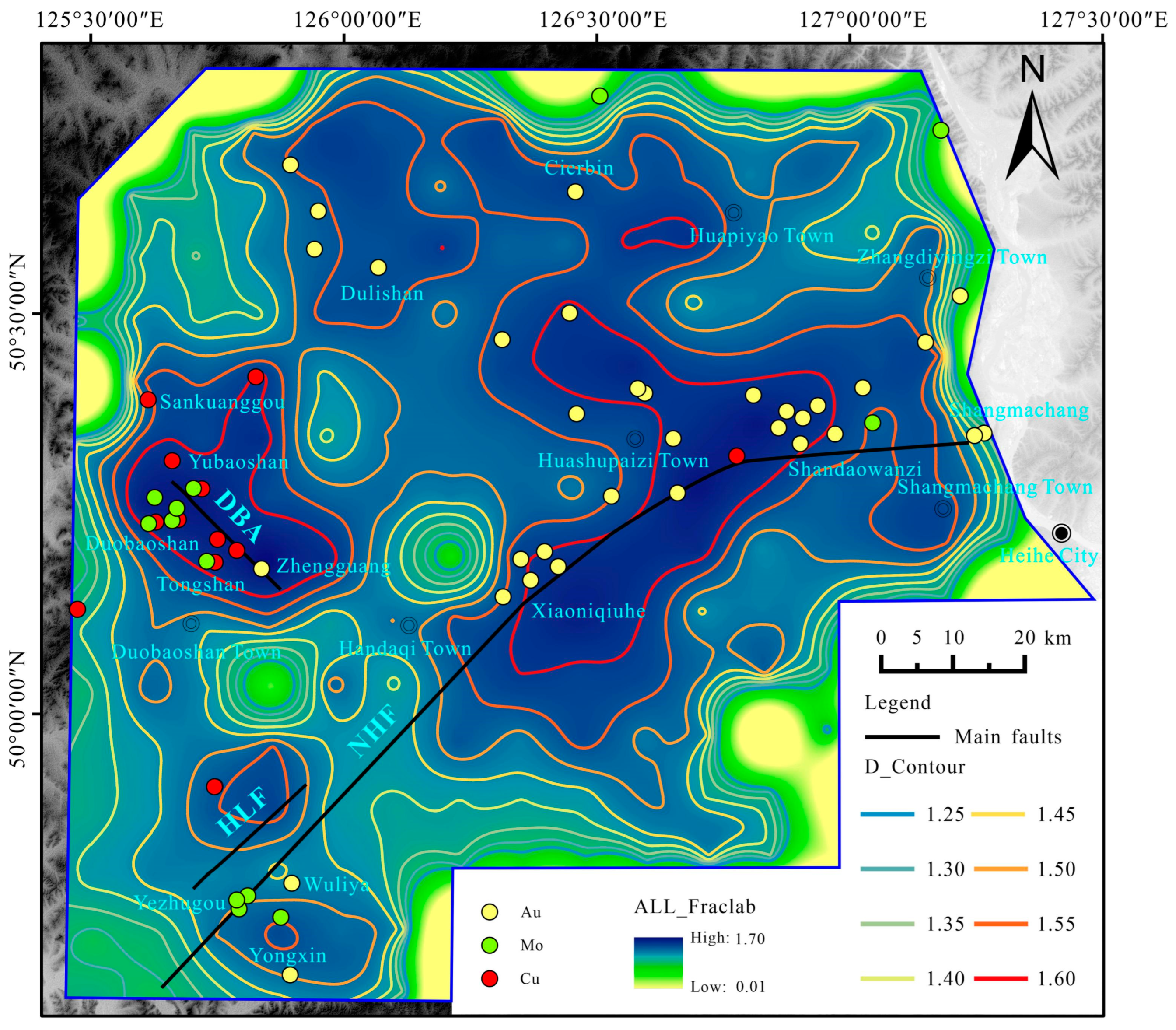

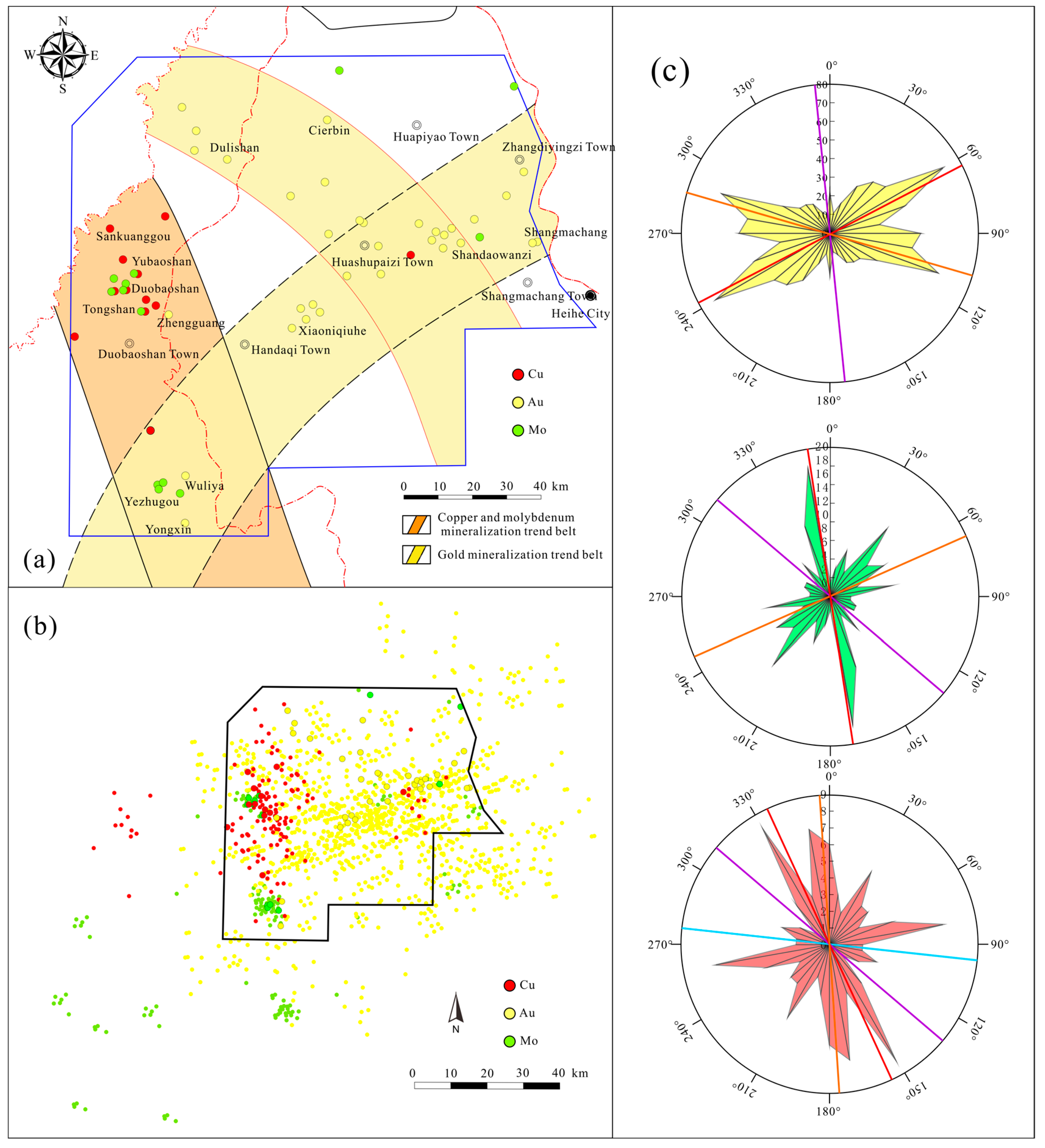
| NO. | Parameters | Code | Values |
|---|---|---|---|
| 1 | Filter Radius | RADI | 80 |
| 2 | Edge Gradient Threshold | GTHR | 10 |
| 3 | Curve Length Threshold | LTHR | 80 |
| 4 | Line Fitting Error Threshold | FTHR | 3 |
| 5 | Angular Difference Threshold | ATHR | 15 |
| 6 | Linking Distance Threshold | DTHR | 10 |
| NO. | Area | Fractal Dimension | Data Source |
|---|---|---|---|
| 1 | All lineaments | 1.622 | This study |
| 2 | The NE lineaments | 1.543 | This study |
| 3 | The NW lineaments | 1.498 | This study |
| 4 | Duobaoshan area structure, Heilongjiang | 1.754 | [82] |
| 5 | Northwest Structure of Dayao Mountain in Guangxi | 1.689 | [22] |
| 6 | Central fault zone of Sichuan Basin, China | 1.530 | [83] |
| 7 | Tongling ore concentration area fracture | 1.279 | [71] |
| 8 | East Kunlun Qimantage Hutouya polymetallic ore field fault | 1.085 | [84] |
| 9 | Shanghang–Yunxiao fault zone, China | 1.360 | [70] |
| 10 | Linear structure in the Guangxi area | 1.335 | [85] |
| 11 | Jiuyishan regional fault in southern Hunan | 1.116 | [20] |
| 12 | Chinese mainland fracture | 1.237 | [86] |
Disclaimer/Publisher’s Note: The statements, opinions and data contained in all publications are solely those of the individual author(s) and contributor(s) and not of MDPI and/or the editor(s). MDPI and/or the editor(s) disclaim responsibility for any injury to people or property resulting from any ideas, methods, instructions or products referred to in the content. |
© 2023 by the authors. Licensee MDPI, Basel, Switzerland. This article is an open access article distributed under the terms and conditions of the Creative Commons Attribution (CC BY) license (https://creativecommons.org/licenses/by/4.0/).
Share and Cite
Zhao, Z.; Chen, J.; Cheng, B.; Liu, Y.; Qiao, K.; Cui, X.; Yin, Y.; Li, C. Spatial Analysis of Structure and Metal Mineralization Based on Fractal Theory and Fry Analysis: A Case Study in Nenjiang−Heihe Metallogenic Belt. Minerals 2023, 13, 313. https://doi.org/10.3390/min13030313
Zhao Z, Chen J, Cheng B, Liu Y, Qiao K, Cui X, Yin Y, Li C. Spatial Analysis of Structure and Metal Mineralization Based on Fractal Theory and Fry Analysis: A Case Study in Nenjiang−Heihe Metallogenic Belt. Minerals. 2023; 13(3):313. https://doi.org/10.3390/min13030313
Chicago/Turabian StyleZhao, Zhonghai, Jun Chen, Binbin Cheng, Yiwen Liu, Kai Qiao, Xiaomeng Cui, Yechang Yin, and Chenglu Li. 2023. "Spatial Analysis of Structure and Metal Mineralization Based on Fractal Theory and Fry Analysis: A Case Study in Nenjiang−Heihe Metallogenic Belt" Minerals 13, no. 3: 313. https://doi.org/10.3390/min13030313
APA StyleZhao, Z., Chen, J., Cheng, B., Liu, Y., Qiao, K., Cui, X., Yin, Y., & Li, C. (2023). Spatial Analysis of Structure and Metal Mineralization Based on Fractal Theory and Fry Analysis: A Case Study in Nenjiang−Heihe Metallogenic Belt. Minerals, 13(3), 313. https://doi.org/10.3390/min13030313







